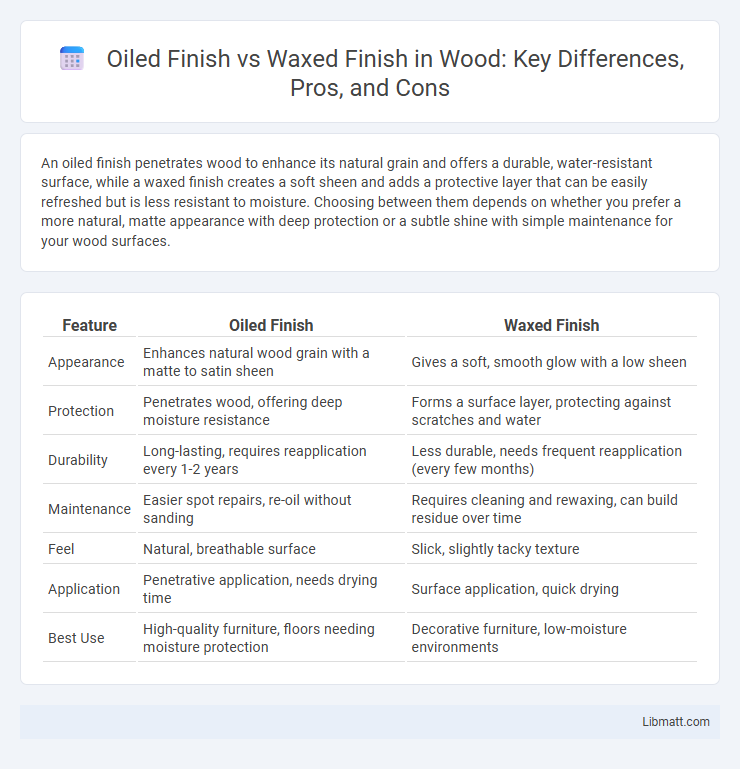An oiled finish penetrates wood to enhance its natural grain and offers a durable, water-resistant surface, while a waxed finish creates a soft sheen and adds a protective layer that can be easily refreshed but is less resistant to moisture. Choosing between them depends on whether you prefer a more natural, matte appearance with deep protection or a subtle shine with simple maintenance for your wood surfaces.
Table of Comparison
| Feature | Oiled Finish | Waxed Finish |
|---|---|---|
| Appearance | Enhances natural wood grain with a matte to satin sheen | Gives a soft, smooth glow with a low sheen |
| Protection | Penetrates wood, offering deep moisture resistance | Forms a surface layer, protecting against scratches and water |
| Durability | Long-lasting, requires reapplication every 1-2 years | Less durable, needs frequent reapplication (every few months) |
| Maintenance | Easier spot repairs, re-oil without sanding | Requires cleaning and rewaxing, can build residue over time |
| Feel | Natural, breathable surface | Slick, slightly tacky texture |
| Application | Penetrative application, needs drying time | Surface application, quick drying |
| Best Use | High-quality furniture, floors needing moisture protection | Decorative furniture, low-moisture environments |
Introduction to Wood Finishes
Oiled finishes penetrate deep into the wood, enhancing its natural grain and providing a durable, water-resistant surface that ages gracefully over time. Waxed finishes create a soft sheen on the surface, offering moderate protection while allowing for easy touch-ups and a smooth, tactile feel. Understanding these differences helps you choose the best wood finish based on desired appearance, maintenance level, and durability.
Understanding Oiled Finish
Oiled finish penetrates deep into wood fibers, enhancing natural grain and offering durable protection against moisture and wear. Unlike waxed finish, which sits on the surface and can wear off more quickly, an oiled finish maintains wood's breathability while providing a rich, matte appearance. You can easily refresh an oiled surface by reapplying oil without stripping the wood, making it ideal for high-traffic areas or frequently used furniture.
What Is Waxed Finish?
A waxed finish involves applying a protective layer of wax to wood surfaces, creating a smooth, matte sheen that enhances the natural grain while providing water resistance and durability. This finish is easy to maintain, allowing for simple spot repairs by reapplying wax without sanding or refinishing the entire surface. You benefit from a warm, tactile feel and a subtle, low-gloss look that ages gracefully over time, making waxed finishes ideal for furniture and wooden flooring.
Application Process: Oil vs Wax
The application process for an oiled finish involves rubbing natural oil into the wood, allowing deep penetration to enhance grain and provide durable protection with periodic reapplication every 6 to 12 months. Waxed finish requires applying a thin layer of wax paste or liquid, then buffing to a smooth, glossy surface that offers surface-level protection but demands more frequent maintenance every 3 to 6 months. Your choice depends on whether you prefer the penetrating, long-lasting qualities of oil or the easy, yet high-maintenance, surface coating of wax.
Durability and Protection
Oiled finishes penetrate wood deeply, enhancing natural grain while providing moderate protection against moisture and wear, making them ideal for surfaces exposed to regular use. Waxed finishes form a thin, protective layer on the surface, offering good resistance to scratches and minor spills but requiring more frequent reapplication to maintain durability. Both finishes improve wood longevity, but oiled finishes generally offer superior long-term protection and easier maintenance in high-traffic areas.
Maintenance Requirements
Oiled finishes require regular reapplication to maintain protection and enhance wood grain, typically every 6 to 12 months depending on wear and exposure. Waxed finishes need more frequent touch-ups, often every 1 to 3 months, to preserve their protective layer and sheen, especially in high-traffic areas. Both finishes benefit from gentle cleaning with pH-neutral products to avoid stripping protective oils or waxes.
Aesthetic Differences
Oiled finishes enhance wood grain with a natural, matte appearance that deepens the wood's color, while waxed finishes create a soft sheen and add a subtle layer of protection with a smoother, polished look. Oiled surfaces tend to highlight the texture and warmth of the wood, providing a raw and organic aesthetic. Waxed finishes offer a more refined and slightly glossy surface that can give furniture a vintage or antique character.
Environmental Impact
Oiled finishes often use natural oils like linseed or tung oil, which are biodegradable and have a lower environmental impact compared to synthetic alternatives. Waxed finishes typically contain beeswax or carnauba wax, both renewable resources, but may include petrochemical solvents that increase environmental concerns. Choosing a finish with non-toxic, plant-based ingredients reduces volatile organic compounds (VOCs) and supports sustainable wood care practices.
Cost Comparison
Oiled finishes typically have a moderate upfront cost, offering a cost-effective solution for durable wood protection, while waxed finishes often require more frequent reapplication, increasing long-term maintenance expenses. The price of oil-based products ranges from $15 to $30 per quart, providing strong penetration and longevity, whereas wax finishes, costing around $10 to $25 per container, offer a more affordable initial investment but less durable surface protection. Budget considerations should factor in the balance between the initial cost of application and the ongoing upkeep frequency associated with each finish type.
Choosing the Right Finish for Your Project
Oiled finish penetrates deeply into the wood, enhancing natural grain and providing a durable, water-resistant surface ideal for high-traffic areas, while waxed finish creates a soft, matte appearance that offers moderate protection and is easy to reapply for a subtle sheen. Your choice depends on the desired aesthetic and maintenance level; oiled finish suits projects requiring longevity and moisture resistance, whereas waxed finish works well for decorative pieces needing gentle upkeep. Consider the project's environment and usage to select the optimal finish that balances beauty with durability.
Oiled finish vs waxed finish Infographic

 libmatt.com
libmatt.com